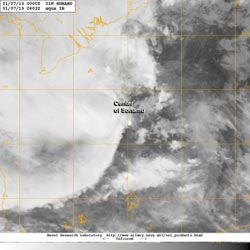Wind shear and dry air bashing Tropical Depression Sonamu

NASA's Aqua satellite passed over Sonamu on Jan. 7, 2013, and noticed that the eastern half of the storm was almost devoid of clouds and showers, which is an effect of the dry air intrusion. The bulk of the cloud cover was west of the center.<br><br>Credit: NASA/NRL<br>
On Sunday, Jan. 6, Tropical Storm Sonamu's maximum sustained winds were near 40 knots (46 mph/74 kph). Sonamu's center was located about 255 nautical miles (258.9 miles/416.7 km) southeast of Ho Chi Minh City, Vietnam, near 7.2 north and 108.9 east and continued to move west. At that time, the ragged low level center became exposed to outer winds. Satellite data showed that the strongest convection and heaviest rainfall was now pushed to the north because of wind shear.
On Monday, Jan. 7, Sonamu was curving to the southwest and is now expected to miss the Malay Peninsula. The Malay Peninsula contains the southernmost tip of Myanmar, Peninsular Malaysia, Singapore, and Southern Thailand. Sonamu is now expected to continue slowly on a southerly track.
Sonamu's maximum sustained winds are down to 30 knots (34.5 mph/55.5. kph). At 1500 UTC (10 a.m. EST/U.S.), Sonamu was located near 6.1 north latitude and 108.3 east longitude, about 290 nautical miles (333.7 miles/537.1 km) south-southeast of Ho Chi Minh City, Vietnam. Sonamu is crawling to the southwest at 1 knot (1 mph/1.8 kph). Sonamu is battling moderate wind shear, which is weakening the storm.
NASA's Aqua satellite passed over Sonamu on Jan. 7 and noticed that the eastern half of the storm was almost devoid of clouds and showers, which is an effect of the dry air intrusion. The Moderate Resolution Imaging Spectroradiometer captured an infrared image of the storm that showed the bulk of the cloud cover was west of the center.
According to the Joint Typhoon Warning Center on Jan. 7, infrared imagery shows a rapidly deteriorating, partially exposed low level circulation center with flaring convection along the western edge of the storm. Water vapor imagery indicated a pocket of dry air is wrapping along the eastern half of the low-level center toward Sonamu's center. Dry air saps convection, which forms the thunderstorms that make up a tropical cyclone.
Forecasters at the Joint Typhoon Warning Center expect that the combination of wind shear and dry air will lead to the dissipation of Sonamu over the next couple of days in the South China Sea.
Media Contact
More Information:
http://www.nasa.govAll latest news from the category: Earth Sciences
Earth Sciences (also referred to as Geosciences), which deals with basic issues surrounding our planet, plays a vital role in the area of energy and raw materials supply.
Earth Sciences comprises subjects such as geology, geography, geological informatics, paleontology, mineralogy, petrography, crystallography, geophysics, geodesy, glaciology, cartography, photogrammetry, meteorology and seismology, early-warning systems, earthquake research and polar research.
Newest articles

Properties of new materials for microchips
… can now be measured well. Reseachers of Delft University of Technology demonstrated measuring performance properties of ultrathin silicon membranes. Making ever smaller and more powerful chips requires new ultrathin…

Floating solar’s potential
… to support sustainable development by addressing climate, water, and energy goals holistically. A new study published this week in Nature Energy raises the potential for floating solar photovoltaics (FPV)…

Skyrmions move at record speeds
… a step towards the computing of the future. An international research team led by scientists from the CNRS1 has discovered that the magnetic nanobubbles2 known as skyrmions can be…




















